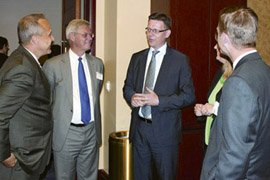
|
| (Left to right) Former Iowa Congressman Jim Nussle; Danish Ambassador Peter Taskoe-Jensen; Grundfos North America president and CEO Jes Munk Hansen; Danish Minister for Trade and Investment Pia Olsen Dyhr; and Novozymes North America president Adam Monroe discuss Grundfos’ energy policies. |
WASHINGTON — Jes Munk Hansen, president, Grundfos North America, recently joined Pia Olsen Dyhr, Danish minister for trade and investment, at a congressional forum in Washington, D.C., to discuss how Grundfos’ home country, Denmark, is meeting the economic, environmental, and energy challenges of the coming decades and how the United States can apply these lessons.
“We need to shift to energy efficiency and independence,” said Congressman Steny Hoyer, D-Md., who presented opening remarks at the event. “Denmark is way ahead of the United States in this quest.”
Thanks to a long-term investment in energy efficiency that began during the 1970 energy crisis, Denmark moved from complete foreign energy dependence to one of the most energy independent nations in the European Union.
Dyhr said Danish companies like Grundfos gained a global advantage by embracing Denmark’s energy-efficient and resource-conservation public policies.
Hansen explained how Grundfos’ autoadapt software ensures that pump systems run only when needed, thereby halving the amount of electricity consumed by traditional pumps that operate at a constant rate.
“We take relatively mundane products and lift them into the new millennium,” said Hansen, who explained that because pumps are normally not visible to the public, few people realize the environmental and economic potential of replacing inefficient pumps. “The U.S. cannot afford the trillions of dollars it would cost to replace its infrastructure. What we need is to make the infrastructure smarter. All it takes is existing technology and a willingness to implement.”
Hansen made it clear that Grundfos could not solve the water and energy challenges on its own and presented the audience with a call to action — a labeling system to increase awareness of the energy savings possible through efficient technology. Such an initiative would help consumers to make informed choices, incentivize the industry to meet higher standards, and benefit the environment through the use of fewer natural resources.
“A labeling system would lift the entire industry to new heights,” Hansen said. “Our elected officials must set ambitious energy goals. Producing energy is one of the biggest consumers of energy. At the same time, moving water accounts for up to 20 percent of electricity use. We need to address this nexus now in order to ensure a positive and prosperous future.”
Publication date: 6/11/2012

Report Abusive Comment